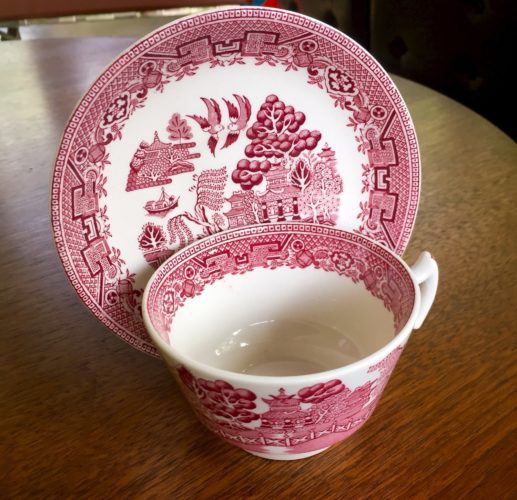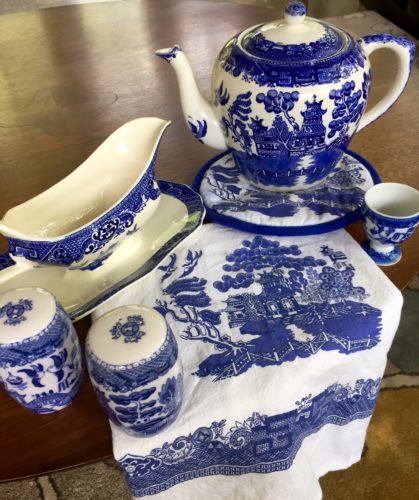Blue Willow Ironstone Ware Made in Occupied Japan
The products and services mentioned below were selected independent of sales and advertising. However, Simplemost may receive a small commission from the purchase of any products or services through an affiliate link to the retailer's website.
When I was growing up, we used the Corelle plates everyone had in the 80s. But when we sat down for nice family dinner it was always Blue Willow china. My mom has a vast Blue Willow collection ranging from plates and teacups to a gravy boat and butter dish. She even has a small oil lamp and clock made from a Blue Willow plate.
Her obsession started as a gift from my grandmother, who passed on her mother's collection. My great-grandma ran a boarding house during the Great Depression, when Blue Willow was widely available and cheap. Oh, the stories those plates could tell!
The history behind Blue Willow china is fascinating and surprising, even for someone who grew up with it. Check out these interesting facts behind the classic pattern.
1. Blue Willow china originated in England
Even though the Blue Willow pattern has a Chinese look and story (more on that later), it was actually created in England in 1780 by engraver Thomas Minton. Then, Minton sold the design to potter Thomas Turner who mass-produced the pattern on earthenware. This is known as chinoiserie, basically European interpretations of Chinese decorative styles. Chinoiserie was very popular in the 17th and 18th centuries. Ultimately, many countries produced it, but it wasn't made in China until the mid-1980s.
2. It had hundreds of makers
It's very hard to date or determine the maker of much of older Blue Willow china, as there are 400 documented makers in Great Britain and 500 worldwide. Spode was an early English maker. And Buffalo Pottery was the first cited producer in America starting in the early 1900s.

3. All authentic patterns have a few things in common
To be a true Blue Willow pattern it must include:
- willow trees
- Chinese pine trees (commonly confused as apple or orange trees)
- a bridge with three men on it
- a fence
- a boat
- a teahouse (or pagoda) and
- two birds in flight.
However, there are thousands of tiny variations. For example, Japanese versions typically have plumper birds than early English patterns.
4. Blue Willow china is an early example of transferware
When Blue Willow was created, many of the expensive Chinese pottery imports were hand-painted. Blue Willow is often cited as one of the first "transferware" prints. Transfer prints started with engravers who etched the pattern into a copper plate that was printed onto porcelain, china or earthenware. Later the pattern was transferred onto paper making it easier to cheaply mass produce.
5. The story behind the pattern isn't real
As a child, I loved hearing my mom tell the story of the star-crossed lovers who transformed into doves that inspired the pattern on our plates. Later, it was a bit of a let down to discover the story was actually just an old version of a marketing ploy to get people to buy the china back when it was first created in England.
6. It isn't just blue
While the classic version of the Willow pattern is blue, it was also created in pink, brown, and even multi-colored. Collectors and experts still typically favor the blue variety.

7. The Blue Plate Special used Blue Willow grill plates
The "Blue Plate Special" which started at diners in the 1920's typically featured a big meal for a great price, served up on a blue plate. Many believe that the preferred dish was the Blue Willow "grill plate" which had separated areas for an entree and sides. Blue Willow had a resurgence around the same time the Blue Plate Special also became popular.
8. It had some pop culture moments
William Randolph Hearst had a special gold-rimmed version of Blue Willow china made for his famous castle on the California coast (so it wouldn't be confused with the lower-cost option). It was also the preferred china pattern of Aunt Bee from "The Andy Griffth Show." In the early days, Blue Willow inspired a comic opera, a silent movie, a children's book and was later featured in many Westerns, to help portray the 19th century.
9. Some Blue Willow china is worth money
Despite its humble reputation as "blue collar china," some Blue Willow is worth thousands. Collectors look for rare, English-made china (1780-1820). It's considered better quality than mass-produced versions made later in China, Japan and the U.S. Unique pieces such as covered dishes and coffee pots are also more valuable than dishes and cups.

10. You can still buy brand new Blue Willow china
The popularity of Blue Willow china hasn't waned. You can still purchase it from department stores, some grocery stores and even Amazon.
If you just like the look of Blue Willow, these new versions are often crisper and more vivid than the originals. English pottery houses, Churchill, Johnson Brothers, and even Spode all still make this classic pattern that has existed for centuries.
Source: https://www.simplemost.com/10-interesting-facts-classic-blue-willow-china/
0 Response to "Blue Willow Ironstone Ware Made in Occupied Japan"
Post a Comment